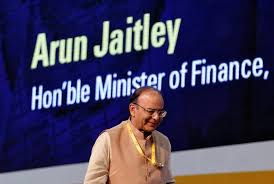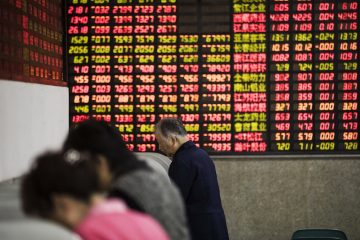India struggles to soothe markets as liquidity concerns grow

MUMBAI (Reuters) – Indian authorities sought to calm markets on Monday but investors paid little heed as fears that the non-banking financial sector is facing a credit crunch hit domestic bonds, stocks and the rupee, adding to Friday’s selloff.
Finance Minister Arun Jaitley tweeted that “the government will take all measures to ensure that adequate liquidity is maintained/provided to the NBFCs,” referring to the non-banking financial companies.
His intervention came on the heels of assurances on Sunday from both the central bank, the Reserve Bank of India, and market regulator, the Securities and Exchange Board of India, that they were closely monitoring developments in financial markets and stood ready to act if needed.
However, the benchmark Nifty Index .NSEI closed 1.58 percent lower on Monday, while the benchmark 10-year bond yield IN071728G=CC was up 2 basis points at 8.10 percent as bond prices dipped. On Friday, the stock index at one stage plunged more than 3 percent in a 30-minute period.
The partially convertible rupee INR=D2 was weaker at 72.54 per dollar versus its previous close at 72.1950 and not far off its record low of 72.99 hit early last week.
Investors have been unnerved by credit concerns surrounding two companies in particular. One of the biggest NBFC names in India – Infrastructure Leasing & Financial Services (IL&FS) ILFSL.UL – this month defaulted on a series of its coupon payments.
Then on Friday, a large fund manager sold short-term bonds issued by home loan provider Dewan Housing Finance (DWNH.NS) at a sharp discount, raising fears of wider liquidity problems in the sector.
“The recent tightness of liquidity in the corporate bond markets indicate a contagion effect may be playing out following the default by IL&FS,” said brokerage firm CLSA in a research note on Monday.
A big correction in equity markets could hurt Prime Minister Narendra Modi and the ruling Bharatiya Janata Party (BJP) as they prepare for a series of key state elections later this year and a national election by May 2019.
Modi and his BJP swept to power in 2014 on the slogan “Achhe din aane waale hain (good days are coming),” but a lack of jobs, falling crop prices and surging fuel costs have triggered discontent and some protests in recent months.
A sell-off in equity markets, which have been one of the few bright spots in the economy, could further dent Modi’s popularity among the small business and trading community, a core base of BJP supporters, who were already stung by two of his largest reform moves – demonetisation and a nationwide Goods and Services Tax (GST).
India’s equity markets have hit record highs in 2018 despite sell-offs in domestic bonds and weakness in the rupee, which has been the worst-performing Asian currency this year.
Despite the correction this month, the Nifty Index is up more than 4 percent so far this year. But for foreign investors, the drop in the rupee will have wiped out any gains.
India’s largest bank, the State Bank of India (SBI.NS), also sought to calm investors, issuing a statement on Sunday saying fears that banks were wary of lending to NBFCs were baseless.
“SBI lends support to NBFCs in the private and public sector within the regulatory policy framework and will continue to do so,” SBI Chairman Rajnish Kumar said in a statement. “There is no concern on liquidity of NBFCs in view of their liquid cash position and availability of committed lines.”
Jaitley is due to chair an annual review meeting with the chiefs of state-run banks on Tuesday, where he is expected to seek updates on their plans to tackle bad loans.
“BEAR PHASE”
With defaults from IL&FS and its group companies on the rise, markets are unlikely to calm down in a hurry.
Late on Monday, the infrastructure developer and lender said it was unable to service certain debt obligations that fell due that day and also missed interest payments on some short-term bonds that were due over the weekend.
Separately, its unit IL&FS Financial Services also said it could not service some debt obligation due Monday.
The RBI, late on Monday, said it has cancelled the certificate of registration for 14 NBFCs on August 1. Just last week, it said it had stripped 30 NBFCs of their registrations on July 12. The central bank did not give a reason for the cancellations. (bit.ly/2pupWXQ)
The head of a mutual fund, who declined to be named due to company policies, said a number of factors from the rupee to oil are not supportive for India.
“The underlying sentiment is so weak the market is not taking any assurances from anybody. It’s not even taking the government at face value any more,” said the mutual fund head.
“The market has entered the bear phase, and when the bears take over panic multiplies.”
The RBI’s attempts to stem declines in the rupee have driven much of the liquidity tightening in the market, as the bank has been selling dollars and sucking up rupees, leading to higher borrowing rates for big borrowers such as the non-banking financial companies.
On Monday, the central bank said it would buy 100 billion Indian rupees ($ 1.38 billion) of government bonds via an open market operation on September 27.
In a note to clients, Morgan Stanley warned that the funding costs for NBFCs are likely to stay elevated for some time.
“We expect markets to be more conservative in lending to NBFCs, which is likely to push up pricing,” Morgan Stanley analyst Anil Agarwal said in the note, warning this would also mean slower growth.



